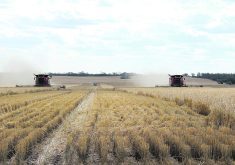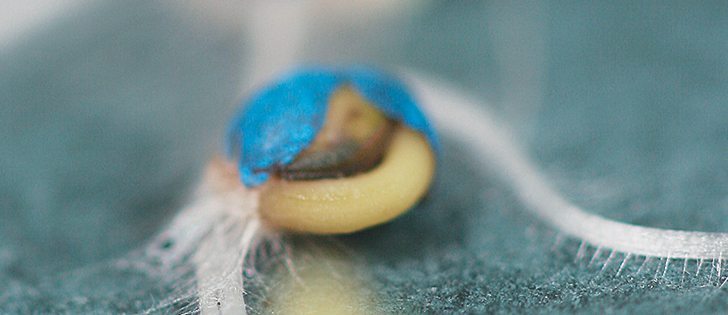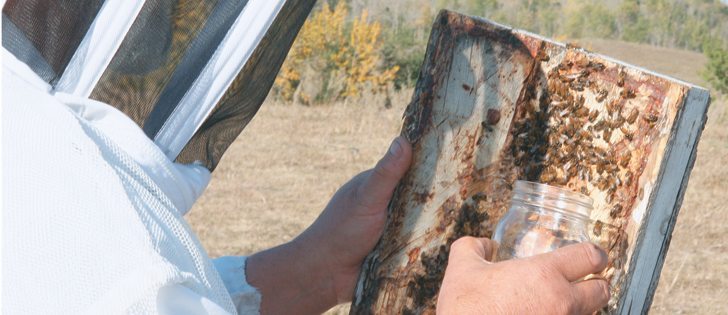Entomologists claim there are less toxic products available; researchers say depending on the pest, alternative treatments are more hazardous
Many growers, crop protection companies and agronomists use a standard line to defend insecticide seed treatments.
The line goes something like this: if neonicotinoid seed treatments were banned, growers would control pests with older insecticides like organophosphates, which are more toxic to bees, wildlife and humans.
Jean-Marc Bonmatin, of the National Centre for Scientific Research in France and a pesticide expert, said that standard argument is bogus, for a couple of reasons:
- For one, farmers only need to control insects on 10 percent of the time for crops like corn and soy. In other words, there’s no need to use alternative insecticides because pest control typically isn’t necessary.
- Two, if pests do reach an economic threshold in crops, farmers can use biological products or use insecticides that are less harmful and less persistent than neonicotinoids.
Read Also

Growing garlic by the thousands in Manitoba
Grower holds a planting party day every fall as a crowd gathers to help put 28,000 plants, and sometimes more, into theground
“Most of the time you don’t need a pesticide… in the vast majority of cases, when I say vast majority it’s about 90 percent (of the time) for crops such as corn, soybeans or sunflowers, ” said Bonmatin, who spoke with Ontario politicians and the media in late May, as part of an event organized by the David Suzuki Foundation.
“If you have to use it, there are a lot of products which are less toxic and less persistent (than neonicotinoids). Less toxic for bees but also for other species.”
Bonmatin was part of the Task Force on Systemic Pesticides, a collection of scientists who reviewed published research on neonicotinoids, which coat nearly all the corn and canola seed in North America and a portion of soybean seeds.
The Task Force released a report on its findings in 2014. www.tfsp.info/worldwide-integrated-assessment/.
Neonicotinoids, commonly known as neonics, have been linked to bee deaths and bee colony losses in Europe and North America. Some scientists believe they are contaminating soil and water, which threatens aquatic insects and the wild birds that depend on those insects for food.
In an interview with The Western Producer, Bonmatin said neonics are used on more than 100 crops and in more than 100 countries.
But he said crops rarely need protection from pests.
“It’s a little bit like antibiotics. Neonics shouldn’t be automatic.”
Bonmatin said producers should employ integrated pest management, such as crop rotations and managing pests with natural predators, before resorting to insecticides.
“In the 10 remaining percent of cases, you still have the choice to treat biologically or use chemicals, as a last resort.”
Bonmatin said neonic seed treatments are used whether pests are present or not. Therefore, they do not belong in an IPM program.
“(Neonic) seed treatments, in my opinion, should be banned because it doesn’t correspond to integrated pest management at all.”
Jeanette Gaultier, Manitoba Agriculture pest specialist, said Bonmatin’s comment that there are safer alternatives to neonics is partly true.
“Sometimes there are less toxic, less persistent insecticide options and other times there aren’t,” she said in an email. “There are some foliar products on the market that are less toxic to bees and less persistent in the environment. Coragen, Bt products like Xentari and Dipel, and Beleaf are all examples. These are definitely alternatives but largely for Lepidoptera and grasshopper control.”
But in the case of other crop pests, like wireworms and seed corn maggot, neonic seed treatments are the only option, she said.
For flea beetles on canola and soybean aphids, the alternatives are more hazardous.
“Foliar options are often limited to organophosphate or pyrethroid insecticides… which have higher bee toxicity and increased exposure potential,” Gaultier said.
Peter Johnson, an agronomist in Ontario, said research indicates that pests threaten about one out of every four fields in the province, higher than Bonmatin’s one in 10 figure.
“The best science that I’ve seen, for Ontario conditions, would suggest that somewhere between 25 and 30 percent of Ontario acres are at risk, at any given time.”
John Gavloski, Manitoba Agriculture entomologist, said earlier this year that five to 20 percent of Manitoba’s soybean acres have wireworm problems and require a neonic seed treatment. He said neonics aren’t necessary on most soybean crops.
“The other 60 to 70 percent (of growers) that have neonic and (don’t) have the wireworm issues, it’s really hit and miss whether they’re going to get any benefit.”
In a draft report leaked to the media last month, Health Canada’s Pest Management Regulatory Agency backed Gavloski’s assessment.
PMRA scientists said neonics provide little to no value to Canada’s soybean industry and the cost may exceed the benefits for soybean producers in Manitoba.
To read more on Ontario agricultural policy see The Western Producer’s opinion piece at www.producer.com/2015/06/who-controls-agricultural-policy-in-ontario/
Contact robert.arnason@producer.com


















